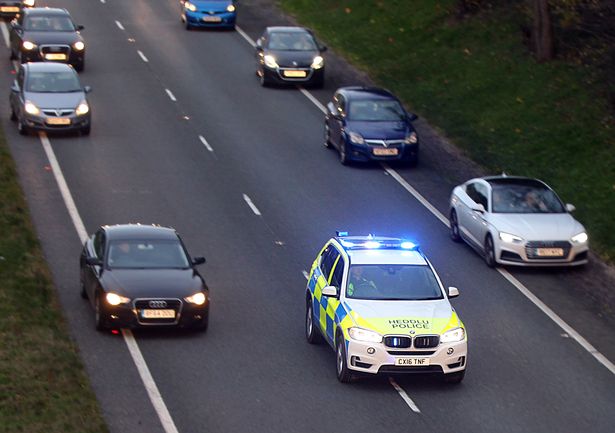Clueless drivers in North Wales baffled by flashing blue lights on roads

Police have issued an alert to drivers across North Wales after noticing some are baffled by the blue flashing lights of emergency vehicles. While many react appropriately, others "don't know what to do" when they see flashing lights behind them or approaching them. Knowing the correct procedures in different scenarios will not only contribute to safer roads, it may also "help to save a life".
Yet North Wales Police[1] officers have reported coming across motorists who risk delaying their responses to emergency call-outs. What to do in these situations is outlined by the Highway Code. This says: "When one approaches, do not panic.
Consider the route of such a vehicle and take appropriate action to let it pass, while complying with all traffic signs. If necessary, pull to the side of the road and stop."
On quiet, straight roads, pulling over is usually straightforward.
In other situations, it may be trickier. North Wales Police is now advising motorists in the region to become acquainted with the right procedures if they haven't already. A spokesperson said: "Emergency responses to situations from police, fire and ambulance can often be hindered by road users either not paying attention to what's behind them or not knowing what to do in those situations."
According to the Highway Code, drivers should always be alert for ambulances, fire engines, police, doctors or other emergency vehicles. Some will be flashing blue lights and sirens, others have red or green lights. Traffic officers and incident support vehicles use flashing amber lights.
Some vehicles might be flashing their headlights. Advice for drivers in different scenarios is offered by the Blue Light Aware resource created by road bodies and charities. It's summarised below. The North Wales Live Whatsapp community for top stories and breaking news is live now - here's how to sign up[4][5]
Where to stop
If you hear a siren or see blue lights, stay calm.
Look for somewhere safe to move left and stop. Keep going on the approach to a bend or on the brow of a hill - then pull over when there's a better view ahead. Stay out of bus lanes, keep off kerbs and pavements, and don't stop near traffic islands.
Solid white lines
On roads with solid white lines, emergency vehicle will probably switch off their siren when behind you.
This is because the road layout doesn't allow for a safe overtaking opportunity. So keep going - at the speed limit if it's safe - until you're clear of the solid white lines. Your clue to pull left and let it pass, is when its siren goes back on.
 Alert drivers on the A55 in Flintshire pull over to give plenty of room for passing emergency vehicles (Image: Ian Cooper/North Wales Live)
Alert drivers on the A55 in Flintshire pull over to give plenty of room for passing emergency vehicles (Image: Ian Cooper/North Wales Live)
Roundabouts and junctions
If you're approaching a roundabout or a junction and you see an emergency vehicle, look at its position, as this will let you know where it wants you to go.
If you're already at the junction, be patient and wait for it to come past. There may be more than one emergency vehicle, so check before moving off.
Traffic lights
At traffic lights emergency vehicles will find a way around you. If you're first in the queue at a red light, stay where you are, and leave the emergency vehicle to find its way around you.
Do not go past the stop line unless directed by a uniformed police officer.
Motorways and dual carriageways
On motorways and dual carriageways, pull over to the left to allow an emergency vehicle to pass in the outside lane if it's clear. If traffic is slowing or stationary and there is no lane for the emergency vehicle, its position will let you know whether to move to the right or the left. When you've let it through, stay where you are as other vehicles are likely to be coming through.
Smart motorways
On a smart motorway, one or more lanes may be closed because of an incident ahead - you'll know because of red X signs above the carriageway.
Emergency vehicles will use these lanes if they can. Keep out of these red X lanes. If no lanes appear to be closed, you can help form what's known as an emergency corridor, so be prepared to move to the right or the left. Sign up for the North Wales Live newsletter[6] sent twice daily to your inbox
Find out what's happening on the roads near you
References
- ^ North Wales Police (www.dailypost.co.uk)
- ^ 500% surge in 20mph offences by North Wales drivers and the two reasons for it (www.dailypost.co.uk)
- ^ Drivers of these car models will have to pay more tax from 2025 (www.dailypost.co.uk)
- ^ Blue Light Aware (orlo.uk)
- ^ The North Wales Live Whatsapp community for top stories and breaking news is live now - here's how to sign up (www.dailypost.co.uk)
- ^ Sign up for the North Wales Live newsletter (www.dailypost.co.uk)